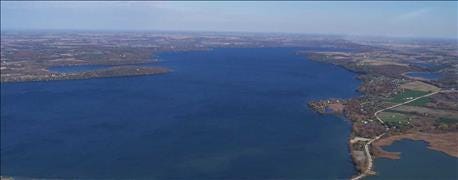
Big Green Lake, in Green Lake County, is Wisconsin’s deepest natural inland lake, measuring 236 feet at its greatest depth. In 2014, the Wisconsin Department of Natural
Resources classified Green Lake as an impaired waterbody for its low dissolved oxygen at middle-lake depths, likely caused by excessive phosphorus.
The visible result is increased weed and algae growth. Water quality issues Green Lake is not alone in its water quality challenges. In Wisconsin, 1,437 bodies of water are classified as impaired because they fail to meet optimal water quality standards. Of those, 562 have high concentrations of phosphorus, and 149 have low concentrations of dissolved oxygen.

DEEPEST LAKE: The Wisconsin Department of Natural Resources classified Big Green Lake as an impaired waterbody for its excessive nutrients, including primarily phosphorus and sediment, in 2014.
Steve Prissel began working last March as a field conservationist for the Green Lake Sanitary District throughout the Green Lake watershed, located in Fond du Lac and Green Lake counties. The Green Lake watershed includes the cities of Ripon and Green Lake and is comprised of 57% farmland. Currently 20% of farmers in the watershed in Fond du Lac County have nutrient management plans and/or are participating in cost-sharing projects, compared with 65% of Green Lake County farmers in the watershed.
“That’s because [the Green Lake County Land Conservation Department] has been working with farmers since they started the program in 1977,” Prissel says. “We’re just getting started in Fond du Lac County. We’re taking baby steps.”
Cost-share projects help
“There are a number of creeks that feed into Big Green Lake,” Prissel says. “Silver Creek, which flows through Ripon, is the main one. The Green Lake watershed stretches 107 square miles. Fifty-two percent of it is coming from Silver Creek.”
Silver Creek contributes 30% of the sediment and 45% of the phosphorus in Green Lake.
Cost-sharing projects farmers can have installed on their farms to limit runoff and nutrients include sediment basins and grassed filter strips. Grassed filter strips put a buffer of land between farm fields and a body of water such as a creek or lake.
“That way, if there is a 1- or 2-inch rain event, the soil doesn’t wash right off the field into the creek,” Prissel explains.
“Sediment basins catch runoff water before it reaches the lake or creek.�”
~~~PAGE_BREAK_HERE~~~
According to Prissel, farmers can receive up to 100% of the cost of the project through cost-sharing funds.
In addition to cost-sharing conservation projects, farmers in the Green Lake watershed who install a grassed filter strip or sediment basin on their farm can receive $246 per acre in rent from the government per year.
“For example, if the grassed filter strip is 5 acres, then the farmer would receive an annual rent payment of $1,250 on the 5 acres for the next 15 years,” Prissel says.
“This land may or may not be the best cropland, because it’s adjacent to a waterway. It may flood part of the year. Profit-wise, with lower prices for corn, soybeans and wheat, it’s a pretty good deal.”
Reduce nutrient load
Stephanie Prellwitz, the executive director of the Green Lake Association, has been working on cleaning up Green Lake since 2013. She has a master’s degree in biological systems engineering from University of Wisconsin-Madison.
Working with farmers to improve soil health and install conservation practices in the Green Lake watershed is critical, according to Prellwitz, though she stresses that efforts are being directed at both urban and rural initiatives.
The overall goal of these various Green Lake partners is to reduce the nutrient load going into Green Lake to improve water quality. Can the lake someday lose its impaired designation?
“Most definitely — that’s what we are all working toward and hoping for,”
Prellwitz says.
Impact of climate change
Climate change is also taking a toll on Green Lake, Prellwitz explains.
“We found from historic precipitation records that Green Lake is getting more intense and more frequent rain events since the 1980s, which can cause increased soil erosion and runoff of phosphorus and sediment,” she says.
That’s not the only climate change-related issue. “We have also seen a reduction in the number of days the lake is frozen over annually,” she says. “Our records go back to 1939. Compared to the 1940s and today, the lake is frozen over about 30 fewer days. Among other issues, that can potentially increase algae and weed growth in the lake.”
~~~PAGE_BREAK_HERE~~~
Prellwitz says there is a connection between phosphorus and algae.
“One pound of phosphorus can fuel the growth of 500 pounds of algae,” she says. “As the algae dies and naturally decomposes, it consumes oxygen in the lake.”
Prellwitz admits cleaning up Green Lake is going to take a long-term approach.
“Every lake has retention time. Retention time is the length of time it would take to fill the lake back up if it were to be completely drained,” she explains.
“Because Green Lake is such a deep lake, it has a retention time of 21 years.”
Compare that with Lake Winnebago, which is a much larger lake that stretches 40 miles between Fond du Lac and Appleton but is only 15.5 feet deep. The retention time for Lake Winnebago is only seven months, Prellwitz says. The retention time for Lake Huron, one of the five Great Lakes, is 22 years — only one year more than Green Lake.
“Even if we were able to stop the flow of all phosphorus and sediment into Green Lake today, it won’t show improvement right away,” Prellwitz says. “It’s going to take time, which is why we have to start our efforts to improve water quality now.”
More information about this project is available by calling Prissel at 920-369-8830.
About the Author(s)
You May Also Like






